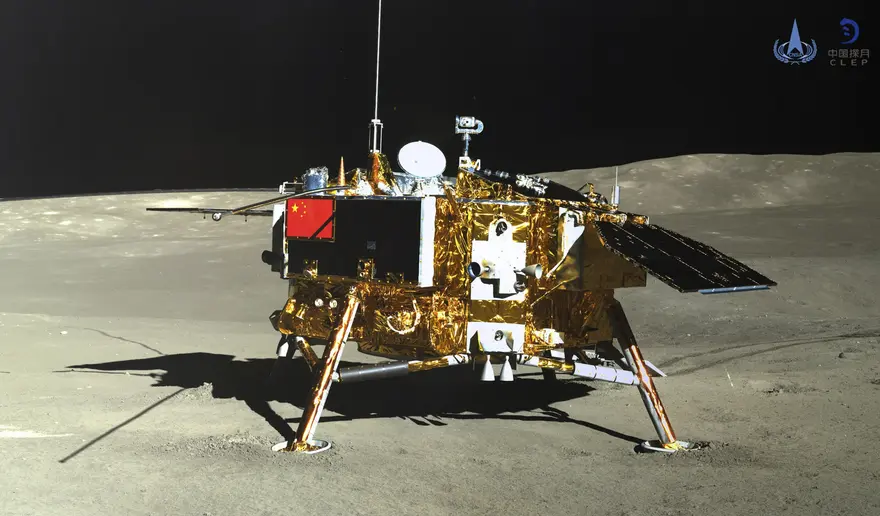China is sending a probe to collect samples from less-explored part of the moon
- May 3, 2024
- 0
China on Friday launched a lunar probe to land on the far side of the moon and return with samples that could shed light on the differences between
China on Friday launched a lunar probe to land on the far side of the moon and return with samples that could shed light on the differences between

China on Friday launched a lunar probe to land on the far side of the moon and return with samples that could shed light on the differences between the less-explored region and the better-known near side. It is the latest development in China’s increasingly sophisticated space exploration program, which currently rivals the United States as the leader in space.
China also has a three-person crew on its own orbiting space station and aims to send astronauts to the moon by 2030. Three Chinese lunar research missions are planned over the next four years.
Free from Earth’s influence and other obstructions, the Moon’s mysterious far side is ideal for radio astronomy and other scientific studies. Since the far side never faces Earth, a relay satellite is needed to maintain communications.
The rocket carrying the Chang’e-6 lunar probe, named after China’s legendary moon goddess, took off from Wenchang Launch Center in Hainan Province at 17:27 on Friday. After about 35 minutes, it completely separated from the massive Long March-5 rocket (China’s largest) that launched it into space; Technicians watching the launch from the ground control point smiled and applauded.
Shortly thereafter, launch mission commander Zhang Zuosheng stepped up to the podium at the front of the hall and announced that the launch had gone exactly as planned and that the spacecraft was moving in its intended orbit. “I declare this launch mission a complete success,” Zhang said to further applause.
The Philippine Space Agency issued a statement saying debris expected from the rocket launch “is believed to have fallen into designated fallout areas.”
In 2021, China was forced to defend its handling of a burning rocket booster over the Indian Ocean after the director of the U.S. space agency and others accused Beijing of acting recklessly by allowing its rocket to crash to Earth after what appeared to be an out-of-control incident. mission.
Large crowds gathered at Hainan Beach to witness the launch, which took place in the middle of China’s five-day May Day holiday. As with previous launches, the event was broadcast live by state broadcaster CCTV.
The vehicle, which orbits the Moon to reduce its speed, will separate from the spacecraft and begin drilling into the Moon’s surface and collecting robotic samples within 48 hours after landing. Once the samples are sealed in the container, they will be reattached to the recycler for the journey back to Earth. The entire mission will take 53 days.
China sent samples from the near side of the moon in 2020, the first since the former Soviet Union in 1976. Analysis of the samples revealed that they contained water in the form of small globules embedded in the lunar soil. Also last week, three Chinese astronauts returned home after a six-month mission aboard the country’s orbiting space station following the arrival of a new crew.
China built its own space station after being kicked off the International Space Station; This was largely due to U.S. concerns that the Chinese military would gain complete control over its space program as technological competition between the two geopolitical rivals intensified. U.S. law prohibits almost any cooperation between the U.S. and China’s space programs without express approval from Congress.
Faced with such restrictions, China has expanded cooperation with other countries and institutions. The latest mission involves scientific instruments from France, Italy and the European Space Agency in collaboration with Sweden. There is also a small Pakistani satellite on board.
China’s ambitious space program aims to send astronauts to the moon by 2030, return samples from Mars in the same year and launch three lunar exploration missions in the next four years. Next is the 2027 calendar.
Long-term plans call for a permanent crew base on the lunar surface, but these appear to remain at the conceptual stage. China launched its first manned space mission in 2003, becoming the third country after the former Soviet Union and the USA to send people into space under its own power.
The three-module Tiangong, much smaller than the ISS, was launched in 2021 and completed 18 months later. It can accommodate six astronauts at a time and is primarily intended for scientific research. The crew will also install space debris containment equipment, conduct payload experiments and deliver science lessons to students on Earth.
China has also announced plans to eventually allow foreign astronauts and space tourists access to the space station. As the ISS’s service life nears its end, China may be the only country or company with a manned station in orbit. The US space program is said to still have a significant advantage over China in terms of costs, supply chains and capabilities.
The US plans to send astronauts back to the Moon’s surface before 2026. But this time, NASA is partnering with private companies like SpaceX and Blue Origin to provide landing modules for astronauts. They plan to land at the moon’s south pole, where permanently shadowed craters are believed to be filled with frozen water.
Source: Port Altele
As an experienced journalist and author, Mary has been reporting on the latest news and trends for over 5 years. With a passion for uncovering the stories behind the headlines, Mary has earned a reputation as a trusted voice in the world of journalism. Her writing style is insightful, engaging and thought-provoking, as she takes a deep dive into the most pressing issues of our time.